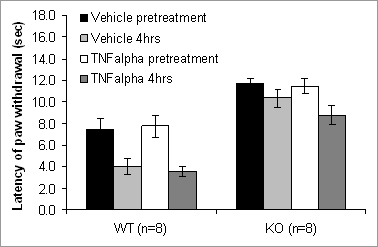Involvement of the TRPV1 receptor in a TNFα induced model of inflammation The TRPV1 receptor is a ligand gated non-selective cation channel found in nociceptive sensory neurons. It can be activated by capsaicin, noxious heat, and extracellular protons. Its activation causes stimulation of the sensory neurons leading to acute pain and neurogenic inflammation (Caterina et al., 2000). Previously in this group, it was found that TRPV1-/- mice exhibit a reduced CFA-induced joint inflammation (Keeble et al., 2004). The aim of this study was to determine whether this observation was related to the actions of TNFα. Age and sex matched C57BL6/129SVJ mice (20-30g), either genetically unaltered wild type (WT) or lacking the TRPV1 receptor gene (TRPV1-/-) (donated from Merck, Sharp & Dohme, UK) were isoflurane (2%) anaesthetised and given intraplantar injections (i.pl) of TNFα (10pmol/50µl) and Tyrode (contralateral paw; 50µl). Thermal nociceptive thresholds were measured using the Hargreaves technique before injection and over a 4 hour time period after injection. The mean of triplicate values was taken as paw withdrawal latency. After 4 hours, mice were humanely killed and paws removed. Paw swelling was measured as paw weight and neutrophil accumulation assessed using a myeloperoxidase (MPO) assay (Shierwagen et al., 1990). Results are expressed as mean of group ± s.e.m and statistical analysis performed using Student’s t-test. Paw weight and MPO accumulation were significantly increased in TNFα treated paws of both WT and TRPV1-/- mice compared to vehicle paws and basal levels (Table 1), whereas TNFα only reduced paw withdrawal latency in WT mice and did so in both treated and vehicle paws, suggesting bilateral hyperalgesia (Figure 1). Table 1. Inflammatory parameters in WT (+/+) and TRPV1-/- mice (-/-). Basal (untreated mice, n=8), vehicle and TNFα values 4h post-injection (n=5) are shown. *p<0.05 compared to vehicle and basal levels.
Figure 1. Thermal nociceptive thresholds before and 4h post-injection in WT and TRPV1-/- mice. *p<0.05 compared to pre- treatment value in same paw.
This data suggests that the TRPV1 receptor mediates thermal hyperalgesia in TNFα induced inflammation and is important in the bilateral hyperalgesia seen here in WT mice. However, it does not appear to play a major role in paw swelling and neutrophil accumulation. Caterina, M.J. et al. (2000). Nature, 288, 306-13. F.R. is funded by a BBSRC/Pfizer Case Studentship. | |||||||||||||||||||||||||


